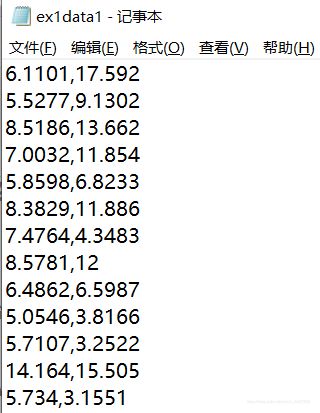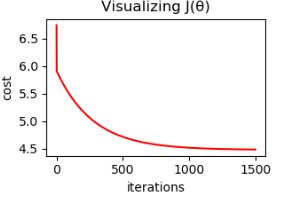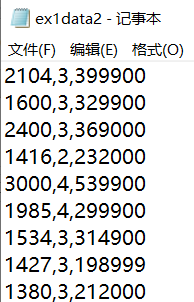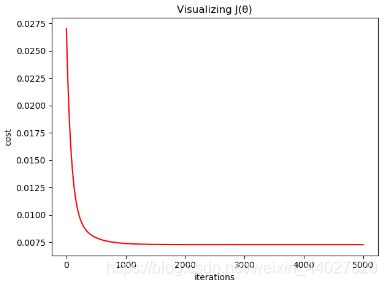吴恩达机器学习课程-作业1-线性回归(python实现)
Machine Learning(Andrew) ex1-Linear Regression
椰汁学习笔记
最近刚学习完吴恩达机器学习的课程,现在开始复习和整理一下课程笔记和作业,我将陆续更新。
Linear regression with one variable
- 2.1 Plotting the Data
首先我们读入数据,先观察数据的内容

数据是一个txt文件,每一行存储一组数据,第一列数据为城市的人口,第二列数据城市饭店的利润。
读入数据时按行读入,每行通过分解,获得两个数据。数据的存储使用列表。初次接触没有使用一些第三方库pandas、numpy,后续会逐渐用到。
# Part1:从txt文件中读取数据,绘制成散点图
f = open("ex1data1.txt", 'r')
population = []
profit = []
for line in f.readlines():
col1 = line.split(',')[0]
col2 = line.split(',')[1].split('\n')[0]
population.append(float(col1))
profit.append(float(col2))
接下来将数据可视化,需要用到matplotlib这个画图库,这个教程还可以
import matplotlib.pyplot as plt
#上面这样引入
plt.title("Scatter plot of training data")
plt.xlabel("population of city")
plt.ylabel("profit")
plt.scatter(population, profit, marker='x')
plt.show()
xlabel和ylabel设置当前图片的x,y轴的标签;scatter绘制散点图,前两个参数为两个坐标轴的对应数值列表(元组等),marker指定绘制点的图形;show函数显示。

- 2.2 Gradient Descent
J ( θ ) = 1 2 m ∑ i = 1 m h θ ( x ( i ) − y ( i ) ) 2 \mathit{J}(\theta) = \frac{1}{2m} \sum_{i=1}^{m}h_\theta(x^{(i)}-y^{(i)})^{2} J(θ)=2m1i=1∑mhθ(x(i)−y(i))2
h θ ( x ) = θ T x = θ 0 + θ 1 x 1 h_{\theta}(x)=\theta^{T}x=\theta_{0}+\theta_{1}x_{1} hθ(x)=θTx=θ0+θ1x1
实现损失函数的计算
c = 0
theta = [0, 0]
for j in range(m):
c += 1.0 / (2 * m) * pow(theta[0] + theta[1] * population[j] - profit[j], 2)
当theta全部初始化为0时,结果为32.072733877455676
θ j = θ j − α 1 m ∑ i = 1 m ( h θ ( x ( i ) − y ( i ) ) ) x j ( i ) (simultaneously update θj for all j) \theta_{j}=\theta_{j}-\alpha\frac{1}{m}\sum_{i=1}^{m}(h_{\theta}(x^{(i)}-y^{(i)}))x^{(i)}_{j}\textrm{(simultaneously update θj for all j)} θj=θj−αm1i=1∑m(hθ(x(i)−y(i)))xj(i)(simultaneously update θj for all j)
在这里第一次进行梯度下降编码,没有使用向量化的编码,只使用for循环遍历,求解。
在进行梯度下降编码时我们首先要弄清楚参数
alpha = 0.01 #学习速率
iterations = 1500 #梯度下降的迭代轮数
theta = [0, 0] #初始化theta
接下来就是梯度下降实现了,第一个循环表示迭代轮数,第二个循环应该是遍历theta,这里数据的维数为二维,相应的theta也只有两个,因此省去了循环。 最内层循环遍历所有数据集。
注意课程中反复强调的所有参数同步更新,需要将计算的theta暂存,所有theta更新完毕后,同时修改原来的theta参数。
# part2:递归下降,同时记录损失值的变化
m = len(population)
alpha = 0.01
iterations = 1500
theta = [0, 0]
for i in range(iterations):
temp0 = theta[0]
temp1 = theta[1]
for j in range(m):
temp0 -= (alpha / m) * (theta[0] + theta[1] * population[j] - profit[j])
temp1 -= (alpha / m) * (theta[0] + theta[1] * population[j] - profit[j]) * population[j]
theta[0] = temp0
theta[1] = temp1
- 2.3 Debugging
下面我们再绘制出最后拟合出来的直线,首先根据数据的范围随意确定X轴头尾两点,再使用拟合出的theta计算出对应的y值,再使用plot函数画出两点及连线。
# part3:绘制回归直线图,已经损失函数变化图
x = [5.0, 22.5]
y = [5.0 * theta[1] + theta[0], 22.5 * theta[1] + theta[0]]
plt.plot(x, y, color="red")
plt.title("Linear Regression")
plt.xlabel("population of city")
plt.ylabel("profit")
plt.scatter(population, profit, marker='x')
- 2.4 Visualizing J(θ)
为了判断拟合结果,可以将损失值随梯度下降过程的变化曲线绘出,帮助我们理解。这里没有像作业上绘制theta和cost的图像,只是简单的绘制cost的变化曲线。因为我觉得这个图理解效果一样。
plt.title("Visualizing J(θ)")
plt.xlabel("iterations")
plt.ylabel("cost")
plt.plot(t, cost, color="red")
# t为迭代轮数,cost为每轮的损失值,这个计算要插入到梯度下降过程中,计算和记录。

可以看到,损失值变化是一直下降,最后保持。因此我们的参数选择是比较好的。特别是学习速率不能取太大,会导致越来越偏离最优值。
Linear regression with multiple variables
首先读入数据,此次的数据,特征包括第一列房子面积,第二列房间个数;第三列为价格。

# 读入数据
f = open("ex1data2.txt", 'r')
house_size = []
bedroom_number = []
house_price = []
for line in f.readlines():
col1 = float(line.split(",")[0])
col2 = float(line.split(",")[1])
col3 = float(line.split(",")[2].split("\n")[0])
house_size.append(col1)
bedroom_number.append(col2)
house_price.append(col3)
- 3.1 Feature Normalization
由于存在多个变量,需要将变量进行归一化,目的是使每个特征对结果影响不被数据数量级影响。
归一化的方法有很多,这篇博客有讲
这里我使用min-max标准化,将数据映射到[-1,1]
x n o r m a l i z e d = x − m e a n p t p , m e a n = a v e r a g e , p t p = m a x − m i n x_{normalized}=\frac{x-mean}{ptp},mean=average,ptp=max-min xnormalized=ptpx−mean,mean=average,ptp=max−min
从此开始我将使用numpy,教程在这,实现如下。由于y的数值也很大,我一并将其归一化。
# 特征归一化
x1 = np.array(house_size).reshape(-1, 1)
x2 = np.array(bedroom_number).reshape(-1, 1)
y = np.array(house_price).reshape(-1, 1)
data = np.concatenate((x1, x2, y), axis=1) # 放在一个ndarray中便于归一化处理
mean = np.mean(data, axis=0) # 计算每一列的均值
ptp = np.ptp(data, axis=0) # 计算每一列的最大最小差值
nor_data = (data - mean) / ptp # 归一化
X = np.insert(nor_data[..., :2], 0, 1, axis=1) # 添加x0=1
y = nor_data[..., -1]
更常用的归一化方法是zero-mean normalization
x n o r m a l i z e d = x − μ σ , μ 为 均 值 , σ 为 方 差 x_{normalized}=\frac{x-\mu}{\sigma},\mu为均值,\sigma为方差 xnormalized=σx−μ,μ为均值,σ为方差
实现方法
mean = np.mean(data, axis=0)
std = np.std(data, axis=0, ddof=1) #除数为m-ddof,ddof默认为0
nor_data = (data - mean) / std
不采用这个方法的原因是,会导致在使用正规矩阵求解是第一个参数为0,还不清楚其中的原因。
- 3.2 Gradient Descent
这里我们使用完全向量化的实现方法,ndarray.dot()为点乘即是内积,可以用@运算符代替,ndarray.T为当前转置。
def gradient_descent(X, theta, y, alpha, iterations):
m = X.shape[0]
c = [] # 存储计算损失值
for i in range(iterations):
theta -= (alpha / m) * X.T.dot(X.dot(theta) - y)
c.append(cost(X, theta, y))
return theta, c
在这里每次梯度下降计算了当前的损失值,用于debug。画出损失值变化曲线。
# 可视化下降过程
plt.title("Visualizing J(θ)")
plt.xlabel("iterations")
plt.ylabel("cost")
plt.plot([i for i in range(iterations)], c, color="red")
plt.show()
当alpha=0.1,iterations=5000时曲线如下:
theta = [-2.47585640e-17 9.52353893e-01 -6.58737388e-02]

- 3.3 Normal Equations
正规方程可以一次计算出theta,根据矩阵变换:
θ = ( X T X ) − 1 X T y \theta=(X^TX)^{-1}X^Ty θ=(XTX)−1XTy
使用numpy可以很方便的实现:
def normal_equation(X, y):
return np.linalg.pinv(X.T.dot(X)).dot(X.T).dot(y)
推荐使用numpy.linalg.pinv()求矩阵的逆
这个方法求解theta只适用在数据量比较小的情况,因为矩阵求逆是个计算复杂度很高的操作。梯度下降的适用性更广。
对比发现,两种方法求出的theta会存在微小不同

完整的代码会同步在我的github
欢迎指正错误
学习的时候参考了Cowry,非常感谢。
